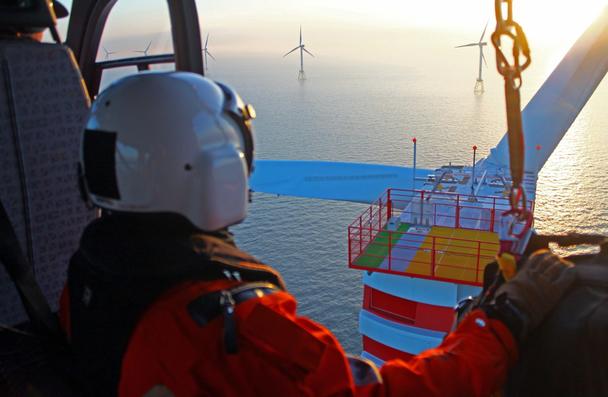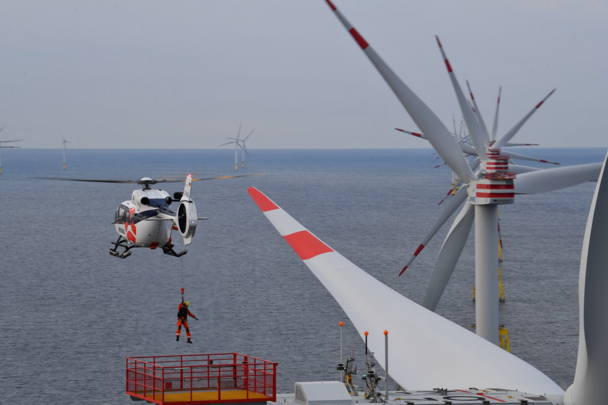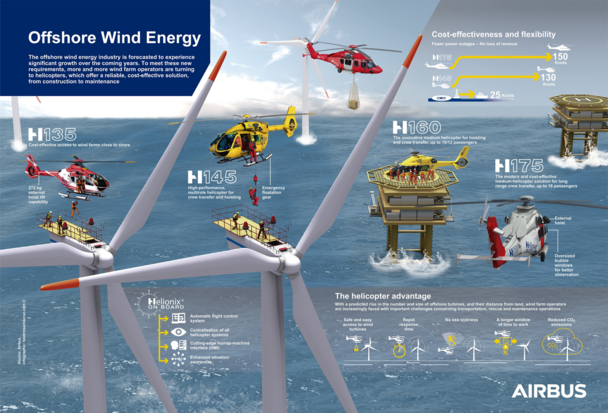Not just a gust of wind

Article: Heather Couthaud
Media: Airbus Helicopters, Celian Bauduin, Getty Images, Ned Dawson, Helicopter Travel Munich (HTM), Wiking Helikopters
On the heels of a record-breaking summer of heatwaves, fires, and weather anomalies – many blamed on climate change – the Paris Agreement’s goals for carbon-emission reductions are more prescient than ever. The push towards investment in renewable energy sources is nowhere more true than in the production of offshore wind energy.
In 2018, 409 offshore turbines were added to the European power grid, offering 2,649 megawatts more net capacity. They joined those already connected, for a total of 4,543 turbines operated by 11 countries. And while wind production in Europe experienced a decline compared to 2017, last year saw an increase in China’s offshore capacity, while new offshore wind markets are being explored in the United States and Japan.
The trend is only set to continue. From January to June 2019, power production from German wind farms in the North Sea increased by 16% compared to 2018. Projects like the North Sea Wind Power Hub, to develop far-offshore wind power installations, are in the works. And those in supporting roles, such as operators of helicopter transport to offshore turbines, are bracing to meet the demand.

In high seas
Some 130 km from shore, in the German Bight area of the North Sea, 100 metre-high wind turbines fan out in the grey morning. Few boats are braving the Sea State 6 conditions, but it’s perfect weather for wind turbines—provided their technicians can make it on site to keep them running.
Year-round, helicopters transport mechanics and equipment to offshore wind farms in nearly all weather. “Weather conditions in the North Sea can be tricky,” says Dennis Roggeveen, a pilot for Helicopter Travel Munich (HTM). “Even if the wave height is really high where boats can [no longer] deliver mechanics to the wind parks, the helicopter is still able to do this job.”
HTM is among several offshore transportation operators using helicopters, particularly the H135 and H145, to hoist technicians to and from wind turbines. Wind farm transfers take about 30 minutes each way, compared to two to three hours’ passage on a boat. To fly passengers to substations, the H135 seats up to six and the H145 eight. For wind farm technician transfers, the H145 can be equipped with a variable number of passenger seats and a hoist operator seat, plus cargo to be either dropped off en route to substations or hoisted to turbines.
“Weather conditions in the North Sea can be tricky,” says Dennis Roggeveen, a pilot for Helicopter Travel Munich (HTM). “Even if the wave height is really high where boats can [no longer] deliver mechanics to the wind parks, the helicopter is still able to do this job.”
Meeting the demand
A number of recent additions to the offshore fleet indicate the sector is growing. Wiking Helicopter Services just took delivery of a new H145, bringing its fleet to four H145s used in sea pilot transfers, and technician wind farm transports from their base Wilhelmshaven, Emden, Wick (UK) and soon from Beccles (UK), Eemshaven and Den Helder (NL).
Both the H135 and H145 use Airbus’ Helionix avionics system, whose four-axis autopilot helps to maintain a stable hover while technicians are winched up and down from the platform. The helicopters are equipped for safety over the water, with a floatation system and external life raft, as well as automatic deployable emergency location transmitter (ADELT), jettison doors, and helicopter emergency exit lightning (HEEL) for faster egress are all buffers against the unexpected. Passengers are briefed before the flight, and must don a survival suit and emergency breathing apparatus.
NHV Group flies to the Rentel offshore wind farm, some 30 km from their base in Ostend, with an H145. In February 2020, the company expects a second H145, which will be used for wind farm hoisting for Ørsted, and will be flying in the Netherlands. NHV has extensive experience in the North Sea with the oil and gas industry, and are using their hoisting expertise – and fleet – to service other customers, like Siemens and GE in the Belgian North Sea. “We saw the market in wind energy was picking up, and it’s also in our strategy to evolve in this market and to renew our fleet,” says Bram de Backer, NHV Base Manager in Ostend.
Not just high flying
The offshore wind industry relies equally on the rapid intervention of helicopters in emergencies. “When we fly offshore with a really critical ill patient then it depends on the complete team to save his life,” says Rüdiger Franz, a doctor with Northern HeliCopters (NHC). “It’s a little different to onshore because we’re on our own, and nobody can help us. We are the only ones who can save his life. That’s one difference; the other difference is that we have to work on small vessels, small ships by day and night, with high waves.”
Nearly all of the North Sea’s helicopter operators count hoisting among their missions. NHV has experience in search and rescue operations, while Wiking also operates HEMS with Offshore Response Safety GmbH to provide 24/7 emergency medical services to offshore wind farms. Both NHV and Wiking perform sea pilot services as well.
“We do see a lot of wind farms being constructed now, and we also support the construction phase by doing crew changes,” says Bram de Backer of NHV. “Five percent of our activities are in the wind farm industry, and we hope we can increase that to 10% in the next few years.”

NHV Group
Founded: 1997
Fleet: 60 helicopters, among which 1 H145 and 12 H175, with another H145 expected in February 2020
Bases: Ostend (Belgium), Aberdeen, Norwich, Den Helder, Rotterdam, Esbjerg, several bases in Norway, France and West Africa and in 2020, Midden-Zeeland (the Netherlands)
Flies to: Rentel offshore wind farm, Borssele 1 and 2 wind farm, Beatrice Wind Farm
Wiking Helicopter Services
Founded: 1975
Fleet: 8 helicopters, including 4 H145s
Bases: Mariensiel, Emden, Husum (Germany), Great Oakley (UK), Wick (UK), Beccles (UK), Visby (S), Bornholm (DK), Helsinki (FI), Den Helder, Eemshaven (NL)
Flies to: Several wind farms, transformer platforms and JackUp vessel(s) platforms in North Sea - Baltic Sea territory
Helicopter Travel Munich (HTM)
Founded: 1997
Fleet: 17 helicopters, including the H135, AS355, AS350, H145 – for the wind farm operations, they use an H145 and up to 4 H135s
Bases: main wind farm base at Emden (Germany), and three additional northern bases: Helgoland, Borkum, and Nord-Norddeich, plus the company’s main base at Taufkirchen/Ottobrunn (Munich) and Salzburg (Austria)
Flies to: twelve different wind farms (e.g. Alpha Ventus wind farm)
Northern HeliCopter (NHC)
Founded: 1991
Fleet: 6 helicopters in the Dauphin family
Bases: Headquarters at Emden; HEMS bases at St. Peter-Ording and Güttin on the island of Rügen
Flies to: German Exclusive Economic Zone (EEZ) in the North Sea and the Baltic Sea

Discover more

